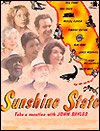| |

BUCCANEERS
PILLAGE AGAIN IN SUNSHINE STATE
 Director-writer
John Sayles's pilgrimage across America to uncover conflicts
of class and race has taken him to Florida in Sunshine
State. The setting is mythical Plantation Island,
though the actual filming took place at a resort on Amelia
Island, Florida. Using short cuts, we learn how the tragic
past seems to cloud the present for nearly everyone. Caucasian
Yankee retirees playing golf think of the era when pirates
discovered Florida and the native Seminole population, but
they are oblivious of a reality that threatens to shatter
the everyday lives of those who have scraped out an existence
in Florida for generations. Among the longtime residents are
the African Americans, who in 1934 pooled their money to buy
property and build houses along Lincoln Beach, a stretch of
sand where swimming is hazardous due to severe undertow. Before
the era of desegregation, Lincoln Beach was a prosperous community,
since Blacks frequented their own establishments, but after
integration their businesses failed as African Americans decided
to spend their money at businesses owned by Whites. Meanwhile,
middle class Whites bought property by Delrona Beach, a swimming
beach, and opened businesses in town to cash in on the tourist
trade, including a motel and café that still maintain
an old-fashioned style but have adapted to the era of "hot
sheets" weekends for singles. Each year a Buccaneer celebration
occurs during the first week of May, but few tourists find
the event sufficiently quaint to distract them from more attractive
opportunities in Orlando and elsewhere. Director-writer
John Sayles's pilgrimage across America to uncover conflicts
of class and race has taken him to Florida in Sunshine
State. The setting is mythical Plantation Island,
though the actual filming took place at a resort on Amelia
Island, Florida. Using short cuts, we learn how the tragic
past seems to cloud the present for nearly everyone. Caucasian
Yankee retirees playing golf think of the era when pirates
discovered Florida and the native Seminole population, but
they are oblivious of a reality that threatens to shatter
the everyday lives of those who have scraped out an existence
in Florida for generations. Among the longtime residents are
the African Americans, who in 1934 pooled their money to buy
property and build houses along Lincoln Beach, a stretch of
sand where swimming is hazardous due to severe undertow. Before
the era of desegregation, Lincoln Beach was a prosperous community,
since Blacks frequented their own establishments, but after
integration their businesses failed as African Americans decided
to spend their money at businesses owned by Whites. Meanwhile,
middle class Whites bought property by Delrona Beach, a swimming
beach, and opened businesses in town to cash in on the tourist
trade, including a motel and café that still maintain
an old-fashioned style but have adapted to the era of "hot
sheets" weekends for singles. Each year a Buccaneer celebration
occurs during the first week of May, but few tourists find
the event sufficiently quaint to distract them from more attractive
opportunities in Orlando and elsewhere.
|
Stressing the same theme that permeated Sayles's Limbo
(1999), developers have purchased a portion of the island
to erect luxury homes, called Exley Plantation, where the
golfers live. With the county zoning commission in their pocket,
the developers are determined to expand the development by
pressuring the oldtimers, Black and White, to sell, telling
them that property taxes will inevitably drive them out anyway.
Similar to Sayles's Lone Star (1996),
the slow-moving film focuses on personal relationships, mostly
on shattered dreams among the less affluent. In addition,
the story features the environmental damage wrought by the
development, including a focus on out-of-state workers who
are imported to bulldoze and re-landscape the newest parcel
to be converted into luxury housing. The climax comes on a
Monday after the close of Buccaneer Week, when the developers
plan to clear land for the next phase of their project. While
many townspeople show up to protest the action, TV cameras
roll when a signal is given to a bulldozer to begin work.
But the bulldozing unexpectedly comes to a complete halt,
for the first scoop of soil uncovers bones of the indigenous
Seminoles, so the land is taken over by government archaeologists.
While the local people can return to life as usual, the out-of-towners
head for the next project in which big money will seek to
disrupt the lives of the less affluent somewhere else; the
next destination for the landscaper is Las Viecas, Puerto
Rico (which the U.S. military until recently used for target
practice). Doubtless, when the landscaper arrives, John Sayles
will be there to film his next epic. MH
ANNUAL
MEMBERSHIP MEETING SCHEDULED FOR AUGUST 11
The annual meeting of members of the Political
Film Society will be held on Sunday, August 11, at 4 p.m.,
at 1215 ½ Seal Way , Seal Beach, California. The main
agenda item is the election of the Board of Directors. All
members are invited.
|
|